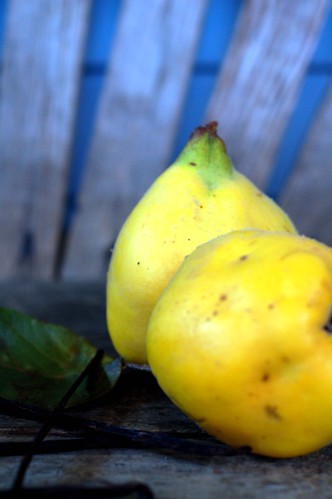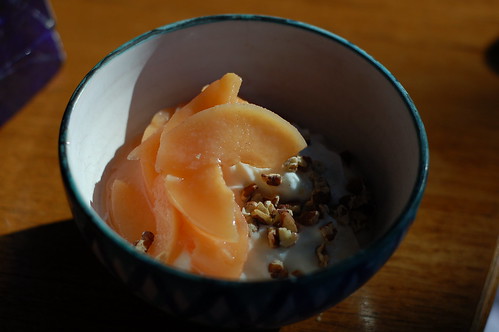Vanilla Poached Quinces
 Sunday, November 7, 2010 at 9:15PM
Sunday, November 7, 2010 at 9:15PM Let’s talk about quinces shall we? They are horribly in fashion, showing up on farmer’s market tables and in the best of food blogs. Before the quince became popular you might see a shriveled one or two at the grocery store near the plantains and star fruit, waiting for someone to take them home and love them. Quinces are used in the United States for sweet dishes – jellies, conserves, and pastes. In Persian cooking, they are served in savory stews and sometimes used as a confection. No matter how you use them, they have to be cooked before eating, they are astringent and harsh. When I cut into them, their texture reminds me of spongy wood. With such descriptions, I can see why you might be turned off. Please don’t, with a little peeling, cutting, water, sugar and time on the stove, the quince is transformed into a lovely rosy fruit that will make you forget all your misgivings about it.
So far this year, I have gone through two of my three basic quince season phases. Elation and joy at the first quinces of the season leading to the making of quince jam and paste, the offering of the quince to my mom for the savory stew and now, the realization that one quince goes a long way when you have been eating them for a while.
This year, instead of canning a lot of quince jam, I decided to just poach my first batch of quinces to have with my morning bowl of yoghurt. Light sugar syrup and a few quinces poached with vanilla and a little lemon can make any morning seem a little brighter. The recipe I typically use comes from Alice Waters’ Chez Panisse Fruit, a great compendium of seasonal fruit recipes that I suggest you pick up and peruse when you have the chance.
Vanilla Poached Quince (adapted from Alice Waters, Chez Panisse Fruit, Harper Collins, 2002)
Makes 2 pts of poached quinces
Cooking time – ca. 1.5 hours, mostly unattended
Ingredients:
2 cups sugar
6 cups water
2 lbs quinces, ca. 4 large
½ vanilla bean
1 lemon
Combine sugar and water in a 4 quart heavy pot. Bring to a boil, stir to dissolve sugar, when dissolved, reduce heat to a simmer. Peel, quarter and remove seeds from quinces, making sure to cut out any bruised or blemished areas. At this point, you can reserve skin, seeds and leftover bits for other uses. * Slice quarters into ¼” slices. Add quince slices to the syrup. Slit vanilla bean in half lengthwise and scrape out seeds and add to syrup. Wash lemon. Slice lemon thinly, into approximately 1/8” slices and add to syrup mixture. Make sure quince slices are submerged in simmering syrup. Waters suggests cutting a parchment round the size of the pot diameter, layer over the fruit and syrup and weigh the parchment down with a plate, the alternative is to stand by stove and use a spoon to keep fruit submerged, you decide.
The quince slices should be tender in about 45 minutes. Remove from heat. If you like heavier syrup, remove slices from syrup, set aside. Bring syrup mixture back to a boil and boil for another 10-15 minutes to thicken up the syrup. Remove from heat and when back to room temperature add back the quince slices and the lemon. The lemon should be transparent and candied at this point and very delicious with the quince.
The syrup and quinces can be stored in the fridge for approximately two weeks, if they last that long. I like to add them to my yoghurt and top the mixture with a teaspoon or two of roasted pecan bits. I have also served them aside a ginger pound cake or topping a French yogurt cake.
There you have it, elation, offerings and realization all in one bowl.
* The skin and seeds of quinces are full of pectin, Christine Ferber, the famous French Jam maker uses quince juice extracted from these discarded bits as the foundation of some of her jellies. For more information, refer to her instructions in her book, Mes Confitures: The Jams and Jellies of Christine Ferber.
 Alice Waters,
Alice Waters,  fall,
fall,  gluten free,
gluten free,  quince,
quince,  vanilla poached quince,
vanilla poached quince,  vegan in
vegan in  recipes
recipes 






